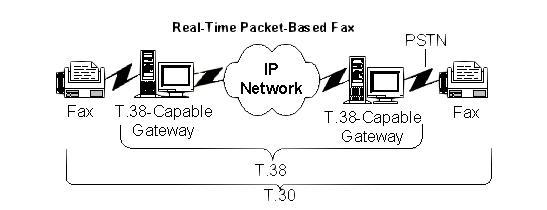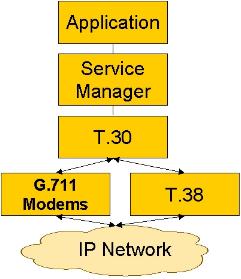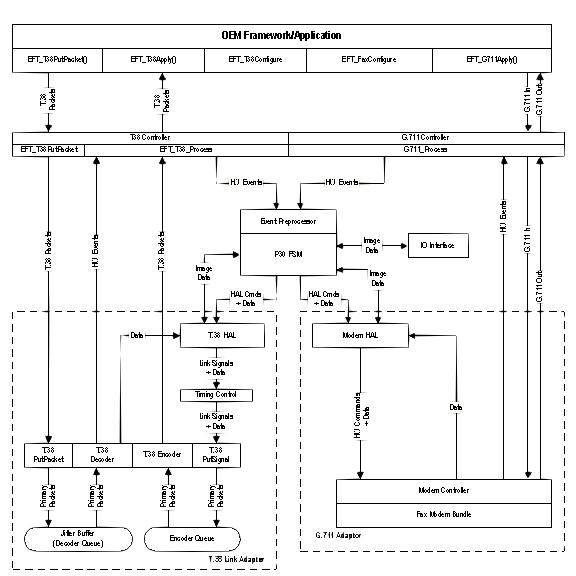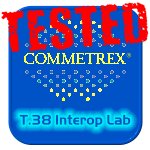Commetrex has developed fax technologies serving the telecom-equipment developer for over a decade, resulting in a rich library of major system components: PortableT30™ (P30) and the Fax Modem Bundle provide PSTN fax termination. Commetrex’ T.38 Fax RelaySoftware (formally PowerRelay™ for T.38) implements the ITU recommendation for real-time IP fax. And TerminatingT38™ combines P30 and T.38 Fax Relay Software to support real-time terminating fax on IP media servers. Multi-Modal Terminating Fax (MMTF) is an integration of all of these major system components to create a system that allows a media server to terminate faxes from PSTN-IP gateways supporting either T.38 or G.711 pass-through for fax transmissions. Several versions are available for Commetrex’ BladeWare host-signal-processing system and for the Texas Instruments TMS320C6000 DSP in XDAIS format.
Multi-Modal Terminating Fax (MMTF)

Smart FoIP, Commetrex’ patent-applied-for technology, is optionally available with T.38 fax relay for use in SIP networks. Smart FoIP eliminates the problems caused by late-arriving T.38 re-Invites from the receiving gateway, which can cause the call to fail if incorrectly accepted by the calling gateway.
Commetrex has found that significant practical problems with SIP negotiations exist in carrier-based SIP networks. After much testing and analysis, we have developed what we call “Smart FoIP”, which improves the reliability of fax-session establishment for ATAs and access gateways. The technology increases the likelihood of a session remaining in G.711 fax pass-through mode, so it also includes a new technology that eliminates PCM-clock synchronization problems.
Features
- Commetrex T.38 Interop Lab certified
- Commetrex’ exclusive TerminatingT38
- Commetrex’ PortableT30 w/V.34 support
- Image Conversion Library
- Fax modems: V.21, V.27ter, V.29, V.17
- Optional V.34 Fax Modem
- Smart FoIP ready
- Fully embedded TI ‘C6000 XDAIS version
- BladeWare ready
- Field proven
- Fully documented
Benefits
- Send and receive faxes from a server to any gateway or Internet-ready fax terminal
- Minimum time to market
- High customer satisfaction
- Easy to integrate
- Highest interoperability
License Options
- Per-port runtime with BladeWare
- Limited-use paid-up source code
- Corporate paid-up source code
- Source with runtime license
- Paid-up object code
- Object code with runtime license
System Overview
With the growing movement towards IP telephony and the release of T.38, the specification for real-time fax over IP, Commetrex developed TerminatingT38. The Company’s field-proven PortableT30 protocol engine was integrated with its T.38 Fax Relay Software (formally PowerRelay) protocol engine in a manner analogous to the way T.30 uses analog modems to process the call stream. (See illustration below.)

This permits the termination of T.38 streams in an IP network on a host computer without the need for modems. TerminatingT38 requires comparatively few MIPS since there is no need for signal processing. (See illustration below.) As a result, TerminatingT38 is suitable for any processing environment that supports the memory requirements and an IP stack.

But, in order to provide fax termination to any IP connection, T.38 alone is not sufficient since not all IP gateways support T.38. Therefore, a system that can terminate a fax session over any IP connection must support both T.38 and packetized G.711, sometimes called G.711 pass-through. (See illustration, preceding page.)
Typically, PortableT30 operates on a host computer or scalar/co-processor, while the fax modems operate on a DSP resource. This partitioning is dictated by the light processing and relatively heavy memory requirements of the T.30 stack and its need to process the TIFF- F file format, and the efficiency of a DSP in processing the sampled data of the analog call stream.
 The core of MMTF is Commetrex’ PortableT30 (P30) finite state machine (FSM). This component contains the T.30 stack, image handling, and ECM (error correcting mode) support. P30 interfaces with either the modem hardware adaptation layer or the T.38 adaptation layer (HAL or the T.38 HAL). Both of these packages present the same interface to the P30 FSM. The P30 FSM sends commands and data to these packages. Internally, each of these packages processes the commands and data to generate output, either as G.711 modem data or T.38 packets. Alternatively, these packages decode external fax data, either as G.711 or as T.38 packets, into data and events. These decoded events are used to trigger the operations of the P30 FSM.
The core of MMTF is Commetrex’ PortableT30 (P30) finite state machine (FSM). This component contains the T.30 stack, image handling, and ECM (error correcting mode) support. P30 interfaces with either the modem hardware adaptation layer or the T.38 adaptation layer (HAL or the T.38 HAL). Both of these packages present the same interface to the P30 FSM. The P30 FSM sends commands and data to these packages. Internally, each of these packages processes the commands and data to generate output, either as G.711 modem data or T.38 packets. Alternatively, these packages decode external fax data, either as G.711 or as T.38 packets, into data and events. These decoded events are used to trigger the operations of the P30 FSM.
MMTF is available in two versions: BladeWare and XDAIS.BladeWare is Commetrex’ host signal processing software framework; XDAIS is a fully embedded version available in the Texas Instruments TMS320C6000 XDAIS format.
BladeWare
For the last few years, the MIPS available on Pentium-class PCs have been adequate to process over 100 media streams while still leaving ample processing power to host several applications. The capacity doubles every 18 months according to Moore’s Law. Blade servers make scaling the number of open- architecture processors in a system as easy as adding a DSP-resource board, and the densities are nearly the same. But, although blade-server architecture makes scaling the number of processors a snap, the software required to harness those MIPS and provide seamless system scaling through the addition of processors has not been available. BladeWare from Commetrex, featuring Open Telecommunications Framework® Kernel and OpenMedia™, solves the problem.
BladeWare is available as a comprehensive software developer’s kit, which supports development of servers that support both voice and fax. BladeWare’s call routing and dynamic resource allocation mean that the application software need not be aware of whether a fax transaction is made over T.38 or G.711 pass- through using host signal processing-based fax modems.
Embedded
In the embedded version of MMTF, the OEM framework/application controls MMTF via the XDAIS “algorithm” interface. It periodically calls MMTF via the apply() function to process/generate T.38 or G.711 packets. The OEM application must call this function every processing period to permit the MMTF to generate outputs and run its timers.
For G.711 mode, the OEM application must supply jitter buffering on the RTP stream. For T.38 mode, MMTF handles the jitter buffering since RTP is not used with T.38.
The memory and processing requirements for the embedded version of MMTF are based on the negotiated options, compilation options and the files involved. The following table summarizes these features of the product.
| MCPS (TMS320C6000) | Per-Channel Memory | ||||
| Options | G711 Mode | T.38 | On-chip | Off-chip | Code+Tables |
| ECM Disabled | 7.9 | 3.45 | 2072 bytes | 48Kbytes | 350Kbytes |
| ECM Enabled | 8.9 | 4.45 | 2072 bytes | 118Kbytes | 350Kbytes |

FoIP Interoperability
 Commetrex has led the industry effort for T.38 interoperability since January 2002, when it launched the T.38 Interoperability Test Lab. Recently, Commetrex has done extensive interoperability testing with the BladeWare HMP telephony platform, with international carriers, service providers, and enterprises.
Commetrex has led the industry effort for T.38 interoperability since January 2002, when it launched the T.38 Interoperability Test Lab. Recently, Commetrex has done extensive interoperability testing with the BladeWare HMP telephony platform, with international carriers, service providers, and enterprises.
Related Publications
- TerminatingT38 Product Bulletin
- BladeWare Product Bulletin
- Fax Modem Bundle Product Bulletin
- PortableT30 Product Bulletin







